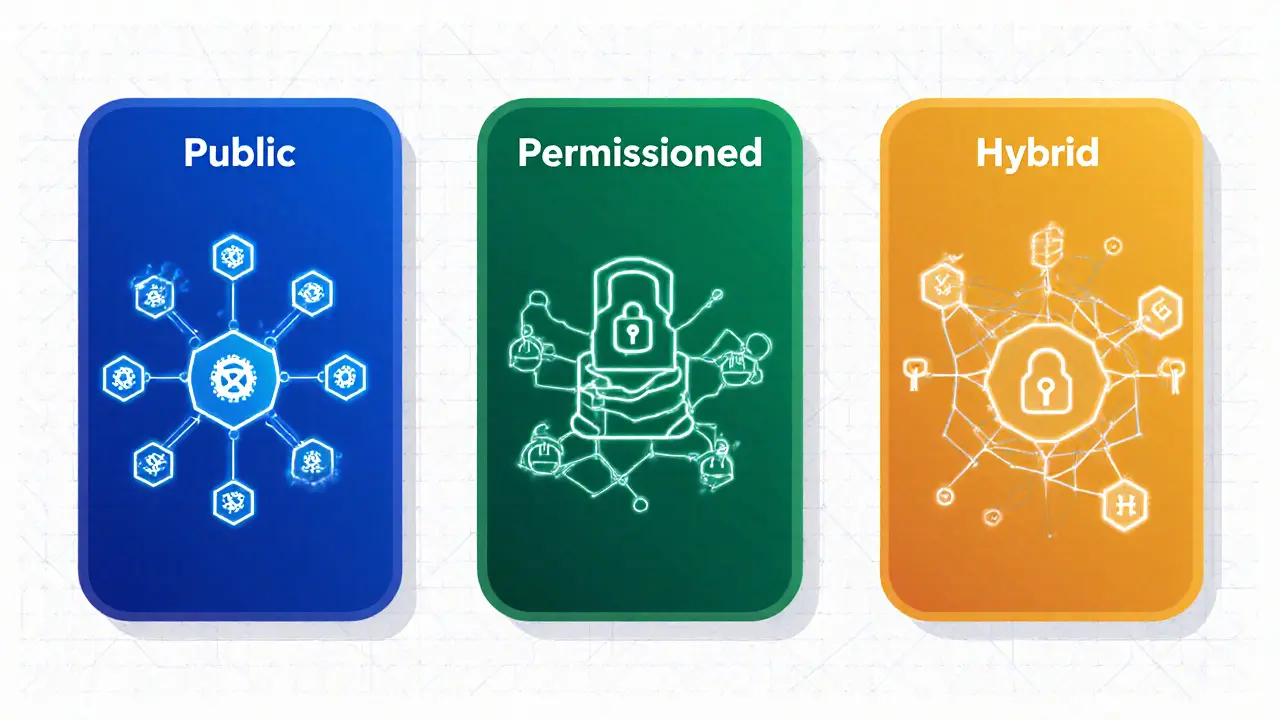Oct 12, 2024, Posted by: Ronan Caverly

Blockchain Supply Chain Comparison Tool
Public Blockchain
Open to all participants; great for maximum transparency but limited privacy.
Permissioned Blockchain
Controlled access; balances privacy with transparency and compliance.
Hybrid Blockchain
Combines public and private features for optimal performance and control.
| Feature | Public | Permissioned | Hybrid |
|---|---|---|---|
| Data Privacy | Open to all; data often encrypted | Access controlled; confidential data kept private | Public anchor for integrity, private channel for details |
| Scalability | Limited by consensus (Proof-of-Work/Proof-of-Stake) | Higher throughput with Raft or BFT algorithms | Combines both, using side-chains for performance |
| Regulatory Fit | Harder to meet strict audit requirements | Easier to enforce KYC/AML policies | Balances transparency with compliance |
| Cost | Usually lower entry fee, but transaction fees can add up | Higher licensing and node-operation costs | Mixed cost model depending on usage |
Select your primary business need to determine the best blockchain architecture:
Recommended Architecture:
Why This Choice:
Key Takeaways
- Blockchain creates an immutable, shared ledger that lets every supply‑chain partner see the same data in real time.
- Smart contracts automate actions like payments or alerts as soon as predefined conditions are met.
- Permissioned networks protect commercial secrets while still delivering end‑to‑end traceability.
- Scalability, standards and partner onboarding remain the biggest hurdles for widespread adoption.
- Layer‑2 scaling, zero‑knowledge proofs and IoT integration are shaping the next generation of transparent supply chains.
Imagine trying to verify where a food‑borne illness originated or proving that a solar panel really contains conflict‑free minerals. Traditional ERP systems give each company a view of its own slice, but the data never quite lines up across the whole chain. That information gap fuels waste, recalls, and mistrust. Blockchain is a decentralized, tamper‑proof digital ledger that records transactions across a network of computers. By letting every stakeholder write to and read from the same ledger, blockchain turns a fragmented mess into a single source of truth.
What Is Blockchain for Supply Chain Transparency?
At its core, a blockchain‑based supply‑chain solution records every hand‑off, test, and certification as an immutable entry. Each block contains a cryptographic hash linking it to the previous block, so altering any past record would break the chain and be rejected by the network. Because the ledger lives on multiple nodes - often owned by different companies - no single party can erase or rewrite data without consensus.
This model solves two long‑standing pain points: visibility and trust. Visibility comes from a shared, real‑time view of product status. Trust emerges because the data itself cannot be secretly changed; it is secured by cryptographic security using public‑private key pairs to sign and verify each transaction. The result is a transparent, auditable record that regulators, auditors and end customers can inspect.
Core Technical Mechanisms
- Immutability: Once a transaction is committed, the cryptographic hash makes it computationally infeasible to alter without re‑writing every subsequent block.
- Decentralization: Control is spread across participants, removing the single point of failure that plagues centralized databases.
- Distributed ledger: Every node stores a copy of the ledger, ensuring all parties see the exact same data at the same time.
- Smart contracts: Self‑executing code that triggers actions (e.g., release payment, raise an alert) when conditions coded into the contract are satisfied.
- Permissioned access: Unlike public blockchains, permissioned networks require identity verification, allowing companies to keep proprietary data private while still sharing needed proof.
These pieces work together to give supply‑chain managers a single version of the truth, while still respecting confidentiality and competitive concerns.
Why Blockchain Beats Traditional ERP and SCM Systems
Legacy systems typically follow a "one‑up/one‑down" model: each company can see only its direct suppliers or customers. In contrast, blockchain provides full‑network visibility. The benefits ripple through the chain:
- Real‑time traceability: Scan a QR code on a pallet and instantly see every previous transaction, test result, and location.
- Automated exception handling: Smart contracts flag temperature breaches or missed customs filings the moment they occur.
- ESG reporting: Immutable records make it easy to prove carbon‑footprint reductions, fair‑labor compliance, or conflict‑free sourcing.
- Reduced fraud: Counterfeit products can be rejected because their provenance cannot be verified on the ledger.
Companies that have piloted blockchain report faster recall cycles (cut by up to 70%), lower verification costs, and stronger supplier relationships.

Real‑World Use Cases
Renault Group migrated its entire parts documentation onto a permissioned blockchain, inviting automotive suppliers to join a shared ledger. The network now records part numbers, compliance certificates, and shipment dates, eliminating redundant paperwork and cutting onboarding time for new vendors.
IBM Food Trust uses blockchain to track berries from farm to grocery shelf. When a contamination alert was issued, the company pinpointed the exact farm and batch within minutes, preventing a nationwide recall.
Resource‑intensive industries such as steel and cement are leveraging blockchain to capture Scope3 emissions. By logging each raw‑material movement, firms can calculate upstream carbon impact with far greater accuracy than legacy spreadsheets.
Implementation Challenges You’ll Face
- Scalability: Public blockchains handle a few dozen transactions per second; supply‑chain networks often need thousands. Layer‑2 solutions and hybrid architectures are emerging, but the problem isn’t solved yet.
- Interoperability: Different partners may prefer Hyperledger Fabric, Corda, or Quorum. Without common standards, data silos can re‑appear.
- Lack of industry‑wide data formats: GS1 is working on standards, but many firms still define their own JSON schemas, making onboarding painful.
- Cost and expertise: Initial licensing, integration with ERP, and staff training can run into six‑figure ranges. Skilled developers familiar with consensus algorithms and smart‑contract languages (e.g., Solidity, Chaincode) are scarce.
- Regulatory compliance: Cross‑border data sharing must respect GDPR, CCPA, and sector‑specific rules like FDA 21CFRPart11.
Addressing these hurdles requires a clear governance framework, shared data standards, and a phased rollout plan.
Choosing the Right Architecture
| Feature | Public | Permissioned | Hybrid |
|---|---|---|---|
| Data Privacy | Open to all; data often encrypted | Access controlled; confidential data kept private | Public anchor for integrity, private channel for details |
| Scalability | Limited by consensus (Proof‑of‑Work/Proof‑of‑Stake) | Higher throughput with Raft or BFT algorithms | Combines both, using side‑chains for performance |
| Regulatory Fit | Harder to meet strict audit requirements | Easier to enforce KYC/AML policies | Balances transparency with compliance |
| Cost | Usually lower entry fee, but transaction fees can add up | Higher licensing and node‑operation costs | Mixed cost model depending on usage |
For most enterprises, a permissioned or hybrid model provides the right mix of privacy, performance, and regulatory compliance.
Roadmap to Adoption
- Define Use‑Case & Value Metrics: Choose a pilot (e.g., high‑value component traceability) and set KPIs such as recall time reduction or verification cost savings.
- Standardize Data Formats: Align with GS1 EPCIS or develop a shared JSON schema that all partners agree to.
- Select Platform: Evaluate IBM Food Trust, Oracle Blockchain Cloud, or open‑source Hyperledger Fabric based on scalability, support, and integration needs.
- Build Governance Model: Set rules for node participation, consensus, and dispute resolution.
- Integrate with ERP/IoT: Connect existing SAP or Oracle modules and attach IoT sensors for automated data capture.
- Run a Controlled Pilot: Onboard a handful of trusted suppliers, monitor performance, and refine smart‑contract logic.
- Scale Gradually: Add more partners, expand to additional product lines, and consider layer‑2 scaling once transaction volume grows.
Typical timelines range from six months for a proof‑of‑concept to 12‑18 months for full‑network rollout.
Future Outlook
Three trends are set to push blockchain deeper into supply‑chain management:
- Layer‑2 and side‑chain solutions that boost throughput without sacrificing security.
- Zero‑knowledge proofs that let participants prove compliance (e.g., CO₂ limits) without revealing raw data.
- IoT‑enabled smart contracts that automatically feed sensor readings (temperature, location) into the ledger, creating truly autonomous supply chains.
Standard‑setting bodies like the Blockchain in Supply Chain Alliance are drafting common data models, which should smooth onboarding for SMEs. As these technical and governance gaps close, expect blockchain supply chain to become a default layer of infrastructure rather than a pilot project.

Frequently Asked Questions
What’s the difference between a public and a permissioned blockchain?
Public blockchains let anyone join and view the ledger, which is great for transparency but weak on privacy. Permissioned blockchains restrict participation to vetted entities, so companies can keep commercial data confidential while still enjoying immutability.
Can blockchain really prevent fraud in supply chains?
It can dramatically reduce fraud because every transaction is cryptographically signed and cannot be altered without consensus. Counterfeit products that lack a valid ledger entry are easy to spot.
How much does it cost to start a blockchain supply‑chain project?
Costs vary widely. A small pilot on an open‑source platform might run under $50,000, while an enterprise‑grade permissioned network with integration and support can exceed $500,000.
What skills does my team need to manage a blockchain network?
You’ll need developers familiar with smart‑contract languages (Solidity, Chaincode), understanding of consensus mechanisms, and project managers who can design governance policies. Many firms also bring in consultants for the first‑year rollout.
Is blockchain environmentally friendly?
Permissioned blockchains use low‑energy consensus algorithms like Raft or BFT, which consume far less power than Bitcoin‑style proof‑of‑work. The environmental impact is comparable to running a standard data center.
Write a comment
Comments
Parker DeWitt
Alright, let’s cut through the hype-blockchain isn’t some magical silver bullet for every supply‑chain headache. Sure, it gives you an immutable ledger, but you still need trustworthy data entry, otherwise you’re just cementing garbage on a fancy chain. 🚀 The real win is when you combine it with IoT sensors that feed verified measurements, not when you just slap a “blockchain” sticker on an old ERP. And don’t forget the cost of running permissioned nodes; it’s not free for the faint‑hearted. If you can afford the infrastructure, go ahead, but remember it’s a tool, not a cure‑all.
October 12, 2024 AT 01:47
Allie Smith
i think this whole thing is actually super exciting! imagine a world where you can scan a product and instantly see its whole journey-no more guesswork. the transparency can boost consumer trust and even help small farms get a fair price. yeah, there are challenges, but they feel totally doable with the right standards. keep pushing forward, folks, the future looks bright! 🌟
October 19, 2024 AT 07:47
Lexie Ludens
Wow, that enthusiasm is contagious, but let’s not pretend the road is all roses. I’ve seen pilots stall because data quality was a nightmare, and the “magic” ledger just reflected the mess. Plus, every new node adds another layer of governance drama-who decides who gets to write? Still, I love the vision, even if the reality sometimes feels like a bad horror flick.
October 26, 2024 AT 13:47
Aaron Casey
From a technical standpoint, the distinction between public and permissioned models is crucial. Public chains excel at decentralization, yet they lack the privacy controls enterprises demand. Permissioned frameworks, such as Hyperledger Fabric, provide identity management and scalable throughput via BFT consensus. Integrating smart contracts can automate compliance checks, reducing OPEX. However, interoperability remains a bottleneck when partners adopt disparate platforms.
November 2, 2024 AT 19:47
Leah Whitney
Great breakdown! To add, when you’re coaching a team through adoption, focus on clear governance rules early on. Define who can deploy chaincode, set up audit trails, and align KPIs like recall time reduction. That way the tech doesn’t become a black box and the team stays motivated.
November 10, 2024 AT 01:47
Lisa Stark
Philosophically, what we’re witnessing is a shift from trusting institutions to trusting algorithms. The ledger becomes the neutral arbiter of truth, but only if the input data is honest. This raises ethical questions about accountability-who bears responsibility when a smart contract enforces a faulty rule? The answer may lie in hybrid models that retain human oversight while leveraging cryptographic guarantees.
November 17, 2024 AT 07:47
Logan Cates
Yeah, but don’t forget the shadows-big tech could embed backdoors in these “neutral” systems, turning the ledger into a surveillance tool. It’s not just about tech; it’s about power dynamics. Stay skeptical, folks.
November 24, 2024 AT 13:47
Shelley Arenson
👍 Absolutely love the collaborative spirit here! When multiple stakeholders join a permissioned network, the shared data can unlock new efficiencies, like automated customs clearance. Let’s keep sharing success stories and learn from each other.
December 1, 2024 AT 19:47
Joel Poncz
Totally agree, and to add a personal note, the biggest hurdle I’ve seen is getting the legal teams on board. Once they see the audit trail and compliance features, they usually come around. Keep the momentum going!
December 9, 2024 AT 01:47
Kris Roberts
One thing that often gets overlooked is the human factor. People need to trust the system enough to actually input accurate data. Training and change management are just as important as the tech stack. When everyone buys in, the blockchain’s benefits really shine.
December 16, 2024 AT 07:47
lalit g
I appreciate that balanced view. In my experience across different cultures, transparency builds confidence, but you also have to respect local data‑privacy laws. A hybrid approach often satisfies both global standards and regional regulations.
December 23, 2024 AT 13:47
Reid Priddy
Let’s not forget that every “transparent” solution is still curated by a handful of insiders who decide what gets recorded. The narrative can be controlled, and the ledger may just reflect the dominant player's perspective. Always question who holds the keys.
December 30, 2024 AT 19:47
Shamalama Dee
That’s a valid point. However, the immutability feature does provide a safeguard against retroactive tampering, which is a step forward compared to traditional databases. Encouraging inclusive governance can mitigate the risk of single‑party dominance.
January 7, 2025 AT 01:47
scott bell
Interesting take! Still, we should ask how “inclusive” is defined in practice. If the onboarding criteria are too strict, you end up with a closed club disguised as a decentralized network. The challenge is to create low‑friction entry without sacrificing security-a delicate balance indeed.
January 14, 2025 AT 07:47
vincent gaytano
Oh sure, let’s all jump on the blockchain bandwagon because it magically solves every supply‑chain nightmare, right? First, you have to wonder why anyone would trust a distributed ledger that was originally designed for speculative crypto trading. The technology was never meant for tracking tomatoes; it’s being repurposed because vendors love buzzwords more than practical solutions. Then there’s the cost-setting up permissioned nodes, hiring blockchain engineers, and maintaining the network can drain budgets faster than a medieval war. Add to that the scalability nightmare; a public chain can barely handle a few dozen transactions per second, while a global supply chain needs thousands. So what do they do? They throw in a layer‑2 sidechain and hope it magically scales, ignoring the fact that interoperability becomes a nightmare of its own. Moreover, the data you feed into the blockchain is only as good as the source-if a farmer enters false pesticide data, the ledger will just cement that lie forever. Smart contracts sound fancy, but they’re just code that can’t understand nuance; they’ll enforce a breach penalty even if a delay was caused by a natural disaster. The promised transparency also raises privacy concerns-companies don’t want competitors to see their cost structures, yet they’re forced to expose hashed data that can be reverse‑engineered. Regulatory compliance is another white elephant; auditors still struggle to interpret blockchain ledgers, leading to a new layer of compliance overhead. Lastly, the hype culture creates a market where consultants sell “blockchain as a service” at premium prices, profitably feeding the illusion of progress. So before you fling your cash at the next pilot, consider whether you’re solving a real problem or just adding another shiny layer to an already complex system. Remember that every new technology brings its own set of legacy issues, and blockchain is no exception. Companies that ignore these pitfalls end up with projects that look impressive on paper but fail in real‑world operations. In short, blockchain can be useful, but it’s not a universal cure‑all.
January 21, 2025 AT 13:47
Dyeshanae Navarro
Well said, and to add a constructive angle, focusing on clear data standards and modest pilot scopes can turn those pitfalls into learning opportunities. Start with a single high‑value product line, define simple JSON schemas, and measure tangible KPIs before scaling.
January 28, 2025 AT 19:47
Matt Potter
Great insights, thanks for sharing!

Author
Ronan Caverly
I'm a blockchain analyst and market strategist bridging crypto and equities. I research protocols, decode tokenomics, and track exchange flows to spot risk and opportunity. I invest privately and advise fintech teams on go-to-market and compliance-aware growth. I also publish weekly insights to help retail and funds navigate digital asset cycles.